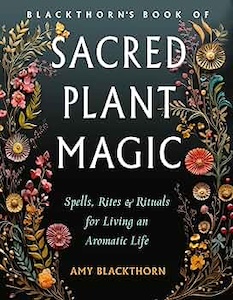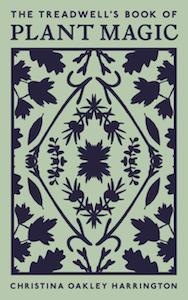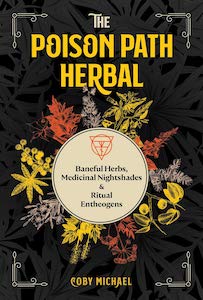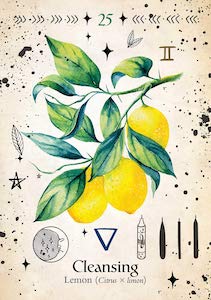
Blackthorn’s Book of Sacred Plant Magic: Spells, Rites, and Rituals for Living an Aromatic Life, by Amy Blackthorn
Weiser Books, 978-1578638307, 272 pages, September 2024
Amy Blackthorn is a renowned herbalist and author of multiple books that are widely used both in the pagan and mainstream communities. Her expertise and deep commitment to the use of plants as both allies and magical companions in all facets of her work is clearly evident in Blackthorn’s Book of Sacred Plant Magic: Spells, Rites, and Rituals for Living an Aromatic Life.
“In this book, I hope to help open your eyes to the connection, the relationships that can be built, and the friends you’ll likely make along the way. We’ll talk about who to build botanical relationships with and why-as well as how to find the magical attributes for plants that aren’t listed in your favorite magical tomes.”1
Blackthorn’s Book of Sacred Plant Magic is organized into two sections and a total of eleven chapters. A multi-page bibliography and brief Plant Index conclude the book. In support of the intention of this title, “Section 1: Creating Relationships with Plants” takes the reader on a journey of introductions to those lesser known plant allies and reacquaints them in a deeper fashion alongside those that are commonly used for magical practice.
“Chapter 1: Scent, Memory, And Personal History” reminds the reader of the importance of scent, from our earliest stages of development as infants to those memories brought into adulthood that remain throughout our lives. The focus is on the association of emotions and the trigger of a specific scent, whether consciously or subconsciously, and the powerful association we have to the smells surrounding us.
As the reader moves through subsequent chapters of the first section, the intention of stepping more closely into relationship with and understanding of the nature of plants/botanicals and the spirit that each holds as its specific energetic signature is slowly and methodically built. Blackthorn has a very accessible style of writing; all the while, she is imparting gems of knowledge that begin the seeding process of what is to bloom.
One of the first exercises is found in “Chapter 2: Developing Plant Spirit Relationships” as the reader is guided to Create Your Visual Landscape to become an inner-lands where plant spirits may be met. Blackthorn provides suggestions for approaching the plant spirits and questions that may be asked. She also reminds that the call may organically come from the botanical spirit and you may not yet even know what a healing relationship with that specific plant may unfold.
“Have you ever been in a plant nursery, hardware store, or even a big-box store and noticed a plant that you knew you just had to purchase, take care of, and get to know? When you feel it in your bones, you know it’s time to get to know that plant, whatever it is. The plant you find can tell you a lot about yourself or your magical needs-and the remedy is that plant.”2
Another feature of this book is the plethora of active workings, spells, recipes, ritual and more that fully engage the reader in setting their own energetic imprint on their personal journey of plant alliances. “Chapter 3: Building Botanical Relationships” takes us on a journey of exploring the energy in plants starting with the simplicity of the spices in your kitchen.
“Take a look inside your kitchen cabinet and you can take a trip around the world. Each spice, herb, and flavor have a rich history of use in medicine, folklore, and witchcraft.”3
“Chapter 5: Plant Spirit Families” is a fascinating backstory for the reader of the origins of the botanical plant names. Blackthorn teaches how plants may be categorized and energetically aligned and the broader families of which they are a part. We are introduced to those botanical members of the Mint, Citrus, Rose and Myrtle Families. Every family has their own particular type of magic and nuance.
Each of the chapters of “Section I: Scent, Memory, And Personal History” provides the foundational information covering many aspects of botanical use as essential oils, aromatherapy, medicinally, and more. Additionally, the properties of each form that a botanical may take and proper uses, cautionary considerations, length of efficacy, storage, and appropriate application are thoughtfully shared. All, in support of cultivating a deep connection and, most importantly, a working magical/mundane and spiritual relationship with your chosen plants.
“Section II: Deeper Connections” jumps right into practical use and application of the properties of botanicals. This section comprises approximately half of the book, making this title a suitable reference source to be returned to as the reader’s journeys into the realm of botanicals evolves and grows.
“Chapter 10: Botanical Listings A-Z” is a cornucopia of over twenty-five botanicals, each offering herbal lore and uses, spells, and a recipe specific to its properties. The result is a complete introduction for the reader to the adaptability and ways in which various plants can be organically woven into mundane and magical practices. Appropriate warnings are placed on those botanicals that may be toxic in specific circumstances along with a reminder to always error on the side of caution.
Blackthorn concludes the journey on a very practical note with recommendations that are invaluable to those readers new to the botanical industry. “Chapter 11: Practical Test for Oil Integrity” offers advice to the botanical shopper seeking prepared botanical oils for their magical work. She notes, “With many shops looking to provide affordable supplies to support their customers, it can be difficult to tell what kind of materials you have in your shop.”4
A list of “Things to Look Out For” such as type of storage bottles, labels, price and enhancements is followed by testing methods that may be employed such as alcohol, water, and paper to determine the authenticity and potency of the product. This offers readers sound advice in exercising discernment around their choices. Although just a few pages in length, the importance of using a product that is what should be expected in quality and price is underscored by Blackthorn for it evokes the sacred action of choosing your plant allies wisely and honoring their power.
Would I Recommend?
Blackthorn’s Book of Sacred Plant Magic is perfect for anyone who is plant curious, working with botanicals, or simply wants to be more connected to the kingdom of plants. It is definitely worth adding to one’s reference library. In keeping with the style of delivery and ease of implementation that is a staple of Blackthorn’s books, this one absolutely delivers and surpasses readers’ expectations. This title, along with any other of Blackthorn’s books, would be a prized gift for consideration as we near the holiday season.
“Everyone has times in their lives when their magic seems out of reach; it’s natural in such a busy, harried culture. I was looking for a reconnect. The full moon came and it was time to venture out into my yard to connect with my land spirits and let them know I hadn’t forgotten them. As I gathered my libations and tools, I had a feeling of peace I hadn’t experienced in a while. This is what I had been missing.5
About the Author: Amy Blackthorn
Amy Blackthorn is a professional intuitive and the bestselling author of several books on botanical magic, including Blackthorn’s Botanical Magic, Blackthorn’s Botanical Brews, and Blackthorn’s Botanical Wellness. The founder of Blackthorn’s Botanicals, she has a certification in aromatherapy and was ordained by the Order of the Golden Gryphon. Amy lives in Delaware. Keep up with Amy’s book news on her website and check out her tea shop.

Robin Fennelly is an Elder within the Assembly of the Sacred Wheel Tradition [www.sacredwheel.org]. She is a dancer, teacher, astrologer, author, ritualist and seeker of all things of a spiritual nature. Her writings and classes incorporate a deep understanding of Eastern practice and Western Hermetics and bring a unique perspective towards integration and synthesis of the Divine and Mundane natures of our being. She is a mother of five and lives in Eastern PA with her husband of 45+ years.










